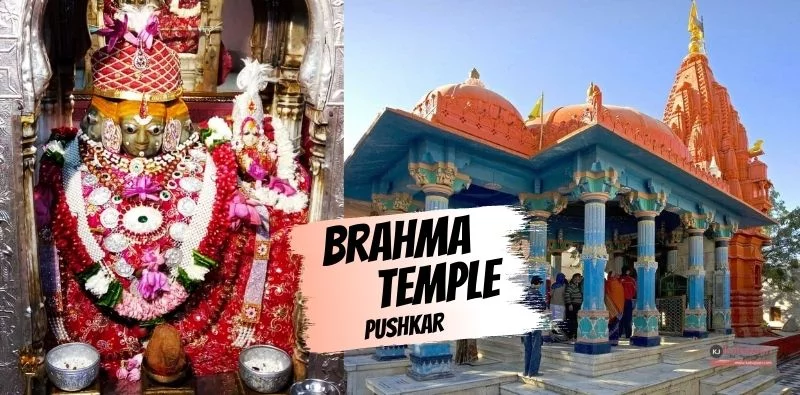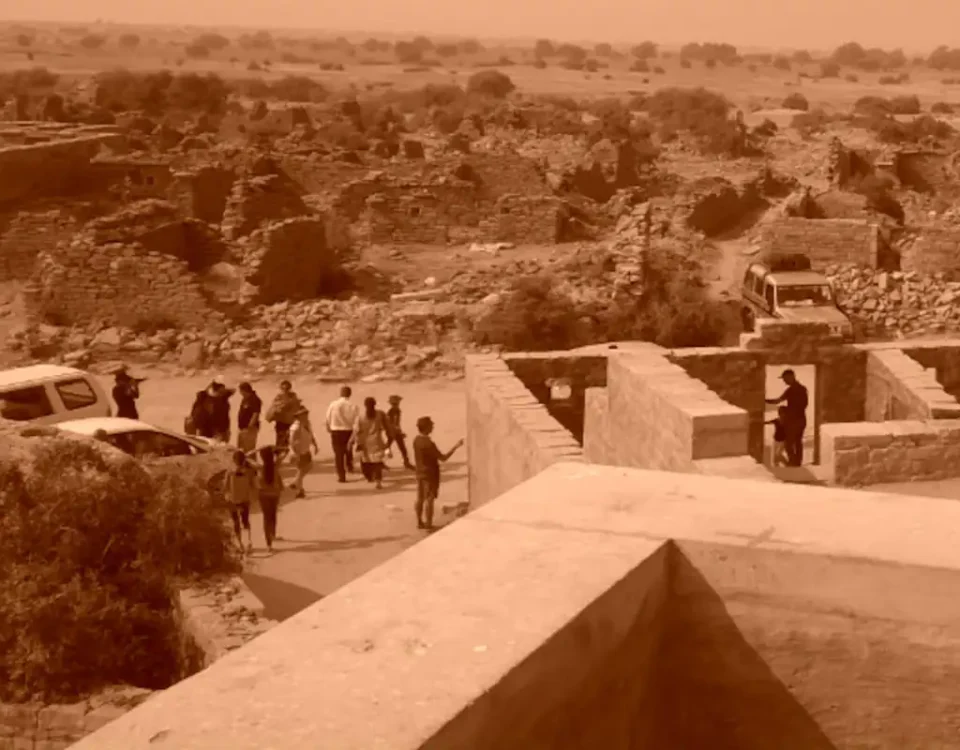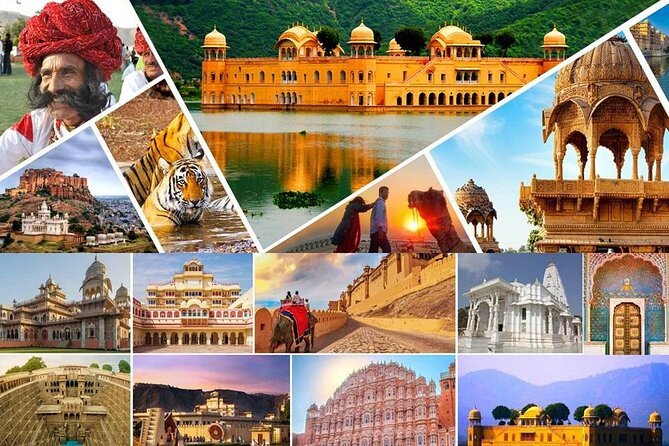- Best Taxi Services In Rajasthan
- +91-9887169999
- hellorajasthantaxi@gmail.com
Brahma Temple Pushkar: Timings, Aarti Schedule & Significance of the Only Brahma Mandir in India

Best Rajasthan Itinerary: Top 10 Places to Visit on a 7 Days Trip to Rajasthan
July 2, 2025
Kuldhara Village, Jaisalmer: Uncovering the Haunted History of Rajasthan’s Abandoned Ghost Village
July 11, 2025Nestled on the serene banks of Pushkar Lake in Rajasthan, the Pushkar Mandir stands as a rare and sacred symbol of divinity—it is the only Brahma Mandir in India. Revered for its profound spiritual energy, Pushkar is one of the oldest and holiest towns in Hinduism, often mentioned in ancient scriptures as a place of pilgrimage. At the heart of this sacred city lies the Brahma Temple Pushkar, where Lord Brahma—the creator of the universe—is worshipped with deep reverence. Devotees and spiritual seekers from across the country visit the Pushkar Ji Temple to offer prayers and participate in sacred rituals at this unique temple dedicated solely to Lord Brahma.
The Only Brahma Temple in India: Why is it Unique?
The Brahma Temple in India, located in Pushkar, holds unmatched spiritual significance as it is one of the very few temples in the world dedicated to Lord Brahma—the creator in the Hindu trinity. According to Hindu mythology, Lord Brahma performed a yajna (sacred ritual) at Pushkar Lake, making it a divine spot. However, due to a curse by his consort Saraswati, Brahma is rarely worshipped elsewhere. This mythological event is described in the Padma Purana, where the lake and the temple are recognized as sacred destinations for attaining moksha (liberation).
What makes the Brahma Temple so unique is not just its rarity but also its continued importance in Vedic tradition. Pilgrims believe that visiting Pushkar and bathing in the lake during Kartik Purnima (usually in October–November) can cleanse sins and lead to salvation. This makes Pushkar a highly revered destination, placing the temple at the spiritual core of Hindu worship despite the lack of other Brahma temples across India.
Location & Architectural Overview
The Brahma Mandir Pushkar is located in the heart of the holy town of Pushkar, Rajasthan—just a short walk from the sacred Pushkar Lake. Surrounded by the Aravalli Hills, the temple is easily accessible and centrally positioned within the vibrant temple town, often buzzing with spiritual seekers, sadhus, and travelers.
Architecturally, the temple is built in classic Rajasthani style using marble and stone slabs. Its distinct red shikhara (spire) and the hamsa (swan) motif atop the temple dome symbolize Brahma’s mount and are visible from afar. Inside the sanctum, the idol of Lord Brahma is depicted with four faces, representing the four Vedas, alongside his consort Gayatri.
Nearby, pilgrims often visit other significant sites such as the Savitri Temple perched atop a hill (accessible via ropeway) and the Varaha Temple. Together, these sacred spots form a spiritual circuit, making Pushkar Ji Temple a central point for religious exploration in the region.
Brahma Temple Pushkar Timings
Here’s a detailed overview of Brahma Temple Pushkar timings for visitors planning a spiritual trip:
- 🕰 Opening Time: 5:30 AM
- 🕰 Closing Time: 9:00 PM
- 🙏 Darshan Timings: Throughout the day (with short breaks during noon hours)
Seasonal Timings Variations
- ☀️ Summer (April to September):
- Morning: 5:30 AM to 1:30 PM
- Evening: 3:00 PM to 9:00 PM
- Morning: 5:30 AM to 1:30 PM
- ❄️ Winter (October to March):
- Morning: 6:00 AM to 1:00 PM
- Evening: 3:00 PM to 8:30 PM
- Morning: 6:00 AM to 1:00 PM
Pushkar Temple Timings – Best Time to Visit
- 🌄 Ideal Time: Early morning (for peaceful darshan) or evening (for scenic views and cooler climate)
- 📅 Best Day: During Kartik Purnima or weekdays to avoid heavy crowds
🛑 Note: Timings may vary slightly on festival days or during maintenance closures. Always confirm locally before planning.
Brahma Temple Aarti Timings & Rituals
The spiritual ambiance of the Brahma Temple comes alive during the daily aartis, where devotees gather to witness sacred rituals that honor Lord Brahma. These ceremonies, set to the rhythm of traditional chants and bells, offer a divine experience that lingers in the heart.
🕉 Types of Aartis Performed:
- Mangala Aarti (Morning Aarti):
Performed at around 5:30 AM to awaken the deity and begin the day with devotion. - Sandhya Aarti (Evening Aarti):
Conducted at around 7:00 PM, it marks the transition from day to night, accompanied by lamps and bhajans.
🔔 Note: The exact Brahma Temple Pushkar Aarti Timings may slightly vary based on season and priest discretion.
🙏 Rituals & Offerings You Can Participate In:
- Pushkar Snan: Devotees often begin their visit by bathing in the holy Pushkar Lake before entering the temple.
- Offering Flowers, Prasad, and Diyas at the altar.
- Circumambulation (Parikrama) around the sanctum.
- Some visitors also light ghee lamps near the temple or donate grains and cloth in traditional belief of earning spiritual merit.
📌 A frequent pilgrim, Meera Devi from Mathura, shared: “The Sandhya Aarti at Brahma Mandir filled my soul with peace—it’s unlike anything I’ve experienced elsewhere.”
These daily rituals not only connect the devotee to the divine but also preserve the spiritual rhythm of Pushkar.
Traveler Tips: Dress Code, Etiquette, and Do’s & Don’ts
Before visiting the sacred Brahma Temple in Pushkar, it’s helpful to know a few cultural norms and temple etiquette to ensure a smooth, respectful, and fulfilling experience:
👗 Dress Code & Decorum
- ✅ Dress Modestly: Wear clothes that cover your shoulders and knees, especially during prayer times.
- 👞 Remove Footwear: Shoes and slippers must be removed before entering temple premises. Use designated racks near the entrance.
- 🙏 Silence is Revered: Maintain quietude within the sanctum to preserve the spiritual atmosphere.
🚫 Restrictions to Keep in Mind
- 📸 No Photography Inside Sanctum: Taking photos or videos near the main idol is strictly prohibited.
- 🧴 No Leather Items: Avoid carrying belts, wallets, or bags made of leather as they are considered disrespectful in many Hindu temples.
- 🛑 Smoking, Eating, or Loud Conversations within temple boundaries is not allowed.
💡 Helpful Visitor Tips
- 💧 Carry a Water Bottle: Especially during summer months—Pushkar can be very dry and hot.
- 🕊 Visit the Ghats: The nearby Pushkar Lake ghats offer peaceful views and opportunities for ritual bathing before darshan.
- 📿 Early Visit Recommended: Arrive early morning to avoid rush and experience morning aarti with fewer crowds.
👣 Respect the temple customs to ensure you’re not just a tourist—but a mindful pilgrim.
Best Time to Visit Pushkar & Brahma Mandir
The ideal time to visit the Brahma Temple in Pushkar is during the cooler months from October to March. This season offers comfortable weather, making temple visits, sightseeing, and outdoor rituals much more pleasant.
🌸 Why October to March?
- 🌤️ Pleasant Climate: Temperatures range between 8°C to 25°C—perfect for early morning darshans and exploring the ghats.
- 📸 Clear Skies: Ideal for capturing scenic photographs of the temple’s red spire and Pushkar Lake.
- 😌 Spiritual Vibe: The calm mornings and spiritual chants in the background create a truly peaceful experience.
🎡 Don’t Miss: Pushkar Fair (Pushkar Mela)
- Held in October/November during Kartik Purnima, this week-long cultural and religious festival attracts lakhs of devotees and tourists.
- Special aartis, spiritual processions, and camel trading events transform the town into a vibrant, once-in-a-lifetime experience.
👥 Crowd Levels & Travel Tips
- 📅 High Crowds: Expect large footfalls during weekends, festivals, and Kartik month.
- 📷 Photography Tip: For golden light and fewer people, visit around 7:00–8:00 AM on weekdays.
- ⏰ Avoid Noon Hours: The sun can be harsh and temple interiors may become crowded.
✨ For a serene and soulful visit, plan your trip early in the season, mid-week, and around sunrise.
How to Reach Brahma Temple Pushkar
Reaching the Brahma Temple Pushkar is easy, thanks to its well-connected location in Rajasthan. Whether you’re traveling from Jaipur or Ajmer, various transportation options suit all types of travelers.
🚗 From Jaipur to Pushkar
- By Road (Taxi or Bus):
Pushkar is approximately 150 km from Jaipur and takes around 3 hours by road. For a comfortable and scenic ride, you can book a private cab via Hello Rajasthan Taxi—a trusted local service offering professional drivers and custom travel options. - By Train:
Take a train from Jaipur to Ajmer Junction (2 hours), then switch to road transport to Pushkar.
🚆 From Ajmer to Pushkar
- By Taxi/Auto-rickshaw:
Pushkar is just 15 km from Ajmer, and local taxis or autos can get you there in 30–40 minutes. - By Bus:
Rajasthan State Roadways operate frequent buses from Ajmer Bus Stand to Pushkar.
🗺️ Travel Tips:
- 🕓 Start Early: Begin your journey in the morning to avoid traffic and enjoy the temple during peaceful hours.
- 📱 Navigation: Use Google Maps and search for “Brahma Temple Pushkar” for accurate routes and real-time directions.
🚕 For a hassle-free and comfortable journey, especially from Jaipur, booking a Jaipur to Pushkar taxi is highly recommended.
Nearby Attractions to Visit
A visit to the Brahma Temple Pushkar is often part of a larger spiritual and cultural experience. Several nearby attractions add depth to your Pushkar journey and are easily accessible by foot or a short ride:
⛩️ Savitri Temple
- Located on a hilltop overlooking Pushkar town, this temple is dedicated to Goddess Savitri, Lord Brahma’s consort.
- You can reach the top via a ropeway ride, offering panoramic views of the town and lake—perfect for photography lovers and spiritual seekers alike.
🌊 Pushkar Lake
- Just a short walk from the temple, this sacred lake is surrounded by 52 ghats, where pilgrims perform ritual baths believed to cleanse sins.
- Ideal for quiet reflection, morning walks, or attending the evening Pushkar Aarti at the ghats.
🐗 Varaha Temple
- Dedicated to Lord Vishnu’s boar incarnation (Varaha), this lesser-known but historic temple is rich in architectural and spiritual value.
- It’s one of the oldest temples in Pushkar and is known for its peaceful environment.
🛍️ Local Markets
- Explore Pushkar’s vibrant bazaars near the temple. You’ll find handcrafted jewelry, camel leather goods, tie-dye fabrics, spiritual books, and more.
- Don’t miss trying local snacks like malpua and lassi from traditional shops nearby.
🧭 These attractions are all within walking distance, making it easy to explore the spiritual heart of Pushkar in a single day.
The Brahma Mandir in Pushkar stands as a rare and powerful symbol of divine creation, spiritual devotion, and ancient heritage. A visit here offers more than rituals—it invites reflection and peace. Plan your spiritual retreat to Pushkar and witness the divine presence of Lord Brahma in India’s most sacred town.



